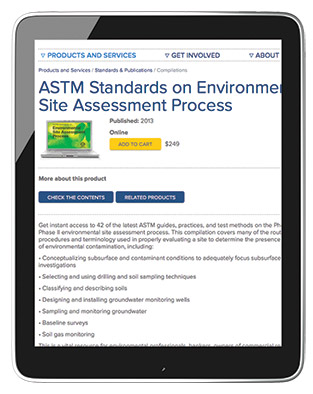
Environmental Site Assessment
The E1527 ESA Standard Continues Guidance with Recent Revision
A revision of ASTM E1527, Practice for Environmental Site Assessments: Phase I Environmental Site Assessment Process, has been issued; it clarifies language and strengthens the report that results from following the standard. E1527 guides those assessing the environmental condition of commercial real estate and identifies "recognized environmental conditions in connection with a property."
E1527, a flagship standard from ASTM International Committee E50 on Environmental Assessment, Risk Management and Corrective Action, has filled a need for guidance on commercial real estate since its initial publication in 1993. With E1527, users can, among other purposes, satisfy U.S. Environmental Protection Agency requirements on conducting "all appropriate inquiries" under the scope of the Comprehensive Environmental Response, Compensation and Liability Act.
Julie Kilgore, president, Wasatch Environmental, Inc., chair of Committee E50 and a former ASTM board member, notes that two primary principles guided the recent revisions to ASTM E1527: to clarify language where there was inconsistency in interpretation and strengthen the deliverable that is produced at the end of the Phase I ESA process.
"The task group looked at terms that were often interpreted quite differently, often resulting in very different end results," says Kilgore. "We also revisited terms that were being applied in a different context than was originally intended. In many cases, the variability in application was not necessarily incorrect, but led to confusion and inconsistency in how information was presented to the end user."
The E1527 Phase I ESA process continues to help determine the potential for hazardous substance or petroleum product release; such releases could lead to liability for new property owners if not identified, evaluated, addressed and properly managed. Kilgore notes that the revisions approved by E50 do not change the process of conducting Phase I ESAs but do clarify the framework, the thought process and the categorization options for the outcome.
Three main groups use E1527:
- Buyers of commercial real estate; U.S. federal legislation in 2002 expanded federal liability protections to include "bona fide prospective purchasers" in an effort to facilitate commercial property transactions on properties where contaminants were known or expected to be present.
- Municipalities or quasi-government agencies required to conduct an environmental site assessment as part of a brownfields grant are included through the 2002 federal legislation.
- Lenders who finance commercial property transactions; they have found ASTM E1527 to be a valuable tool for evaluating and managing environmental risks as part of their overall loan considerations.
"Often, the Phase I ESA identifies legacy contamination, the potential for soil or groundwater impacts from activities conducted long ago," says Kilgore. "But as we move forward in a more sophisticated environment of managing risks from past releases, we as an industry are also creating what I call legacy remedies, which really means that since it's often not economically viable to remove all past contamination, as a society we accept and acknowledge that some contaminants can remain in place as long as they are managed correctly." Kilgore says that Phase I ESA serves to ensure that current and future property owners are aware of such legacy remedies and the obligations that go with them.
"It is important for a property owner to know that, for example, a day care or assisted living facility is not an approved use of certain properties," says Kilgore. "Or perhaps there will be some soil, groundwater or dust control management issues if a property owner wants to redevelop or build an addition."
 SN Home
SN Home Archive
Archive Advertisers
Advertisers Masthead
Masthead RateCard
RateCard Subscribe
Subscribe Email Editor
Email Editor